 |
|
|
BiblePlaces Newsletter
Vol 5, #1 -
January 9, 2006
Two new developments have me excited. They are also the cause
for the lack of one of these newsletters since October. The
first is a new website. It took steady work throughout all of
2005 to get this up and running and the results are, I believe,
impressive.
Entitled Life in the Holy
Land, this website is the historic counterpart to
BiblePlaces.com. Whereas
BiblePlaces.com give you the
"here and now," Life in the
Holy Land gives you the "there and then."

There is more to come, but we're launching it with five major
regional categories (Galilee, Jerusalem, Judah, Lebanon, Egypt) and
three cultural categories (the Bible Illustrated, Peoples of the Holy
Land, and Way of Life). Altogether there are more than 100 pages and 400
illustrations. I think it is unique in the internet. There are sites
with lots of thumbnail pictures and no explanations, and other sites
with entire books but no pictures, but this combines the best of both.
Take a look! And
if you can add a link from your website, please do! (and see below)
Second, I have started the
BiblePlaces Blog to feature the latest news and analysis of interest
in between newsletter editions. Bookmark this
and check it periodically or add
the feed to your RSS
reader. (One free offer that I linked to on the blog was extended
to Jan. 8, but appears to still be working as of the 9th.)
editions. Bookmark this
and check it periodically or add
the feed to your RSS
reader. (One free offer that I linked to on the blog was extended
to Jan. 8, but appears to still be working as of the 9th.)
I wish you the best for the New Year. May the Lord's will be
done in this country and in yours.
Todd Bolen
Editor, BiblePlaces.com
Assoc. Professor, The Master's College
Israel
Bible Extension (IBEX), Judean
Hills, Israel
News from Israel
Anchors found in Dead Sea
Two wooden anchors found in the Dead Sea are now on display in the
Israel Museum, and are remarkable both for their size and their
preservation. These anchors were revealed as the level of the Dead Sea
continues to drop, and archaeologists date the two anchors to 500 B.C. and
the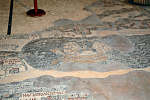 1st century A.D. The metal portions of the anchors have corroded away, but
the wooden pieces and some of the attached ropes remain. These anchors
attest to a time of flourishing boat traffic on the Dead Sea as depicted
on the Medeba Map (600 A.D.). Archaeologists are hopeful that as the
water level recedes, intact boats may be recovered. For more
information, see the
Jerusalem Post article.
1st century A.D. The metal portions of the anchors have corroded away, but
the wooden pieces and some of the attached ropes remain. These anchors
attest to a time of flourishing boat traffic on the Dead Sea as depicted
on the Medeba Map (600 A.D.). Archaeologists are hopeful that as the
water level recedes, intact boats may be recovered. For more
information, see the
Jerusalem Post article.
Ancient Prison Cells Found in Tiberias
Excavations of an important administrative building continue in
Tiberias and recently archaeologists have
 cleared
what they believe were detention cells for prisoners. Measuring about 6
by 9 feet (1.8 x 2.7 m), the cells have walls that are about 3.5 feet
(1.1 m) thick. The cells probably were not used for long-term prisoners,
but instead held those awaiting trial. More information and a
photo can be found in the
Haaretz article. cleared
what they believe were detention cells for prisoners. Measuring about 6
by 9 feet (1.8 x 2.7 m), the cells have walls that are about 3.5 feet
(1.1 m) thick. The cells probably were not used for long-term prisoners,
but instead held those awaiting trial. More information and a
photo can be found in the
Haaretz article.
Follow-Ups to Previous
Stories More on the "Palace of David"
The Washington Post has a story on the
City of David excavations and the
"palace of David." The use of the Bible in archaeological work is
discussed, as is the political angle.
Biblical Archaeology Review
has also made available its
article [link no longer valid] on the
palace, written by the excavator, Eilat Mazar. I was at the site last
week and noticed that the entire excavation area is being covered with
steel girders, probably both for protection of the remains and to
allow the modern courtyard above to be completed.
|
 |
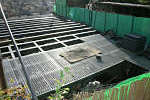 |
|
Aug 2005 |
Dec 2005 |
Don't Tell, Show Someone Else
At the encouragement of a big fan of the Pictorial Library of Bible
Lands, I recently finished creating a PowerPoint "demo" that explains more of the features and advantages of the
Pictorial Library collection. This is not publicly available, but
if you'd like to tell your class, friends or anyone else why the
Pictorial Library is so valuable,
send me an email with a
short note as to how you would use it and I'll send the demo to you.
The presentation is largely self-explanatory.
"demo" that explains more of the features and advantages of the
Pictorial Library collection. This is not publicly available, but
if you'd like to tell your class, friends or anyone else why the
Pictorial Library is so valuable,
send me an email with a
short note as to how you would use it and I'll send the demo to you.
The presentation is largely self-explanatory.
Special Offer: Free CD
The new website,
Life in the Holy Land, needs "friends" :-). All of the work that has
and will be invested in it will not be of use if people do not know about it.
If you have a website (or blog) and would put a link to
Life in the Holy Land, we'll send you a free CD. Or ask your friend, school, or church to add a link
to the site. If you do, send
me 1) the website where the link has been added; 2) your choice of CD; 3)
your mailing address. I'm traveling the rest of the week, so I won't be
able to respond immediately, but I will. Thank you for helping to spread
the word.
send you a free CD. Or ask your friend, school, or church to add a link
to the site. If you do, send
me 1) the website where the link has been added; 2) your choice of CD; 3)
your mailing address. I'm traveling the rest of the week, so I won't be
able to respond immediately, but I will. Thank you for helping to spread
the word.
Featured BiblePlaces Photos:
Nazareth Village
If you're one of those who prefers a rural hillside to an icon-filled
church for visualizing the biblical sites, some of the most important
places in Jesus' life are the most disappointing. The place of
Jesus' birth, Bethlehem, and the place of his home until age 30,
Nazareth, are large, crowded cities today. The best that one can
do is visit the churches built over the "holy sites" or to escape the
city altogether.
Such is no longer the case in Nazareth, with the completion of
"Nazareth Village."
Situated in the heart of the modern city, this re-creation of a 1st
century town illustrates ancient life in
Jesus' hometown. Local people play the parts of ancient farmers,
carpenters, and weavers, demonstrating and explaining their crafts.
This month's featured photos should help you to better understand and
illustrate Scripture, and hopefully will encourage you to make Nazareth
Village a stop on your next trip to Israel.
Each photo is linked to a higher-resolution
version which may be used freely for personal and educational purposes.
Commercial use requires separate permission. These photos are also
available for download in a
PowerPoint file
(2.3 MB). For more
high-quality, high-resolution photographs and illustrations of biblical
sites, purchase the
Pictorial Library of
Bible Lands or the
Historic Views of
the Holy Land series.
|
|
The Farmer
|
|

Click picture for higher-resolution version.
|
|
During construction of Nazareth Village, excavators
discovered that this area had been farmed in the Roman period.
Remains of ancient terraces and a winepress were revealed, and these
may have been in use in the 1st century when Jesus lived in the
village. |
|
Threshing Floor |
|
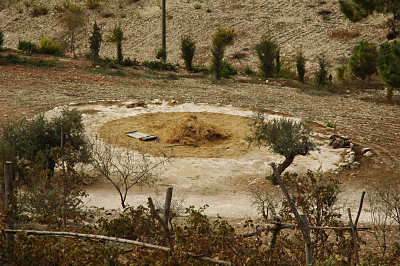
Click picture
for higher-resolution version.
|
|
Because Nazareth Village was established
as a working farm, the visitor's experience changes throughout the year.
In the fall, the fields are plowed and planted, and in the spring the
wheat is harvested and brought to the threshing floor. Here the
threshing sledge separates the grain from the straw, and then the grain
was tossed into the air and the wind would carry away the chaff.
For older photos depicting this process, see
Life in the Holy
Land. |
| The Well |
|
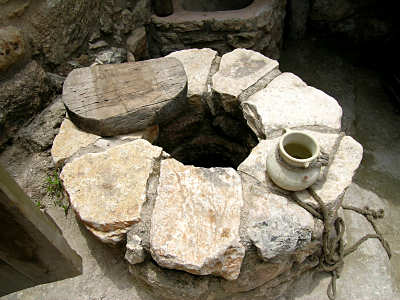
Click picture
for higher-resolution version.
|
| Water is life, and if a spring wasn't
nearby, a well or cistern is necessary. Wells were preferred
to cisterns because they accessed the water table directly.
Cisterns were simply plastered tanks which stored whatever rainwater
could be collected. For older photos about the "Woman at the
Well," see
Life in
the Holy Land. |
|
Houses |
|
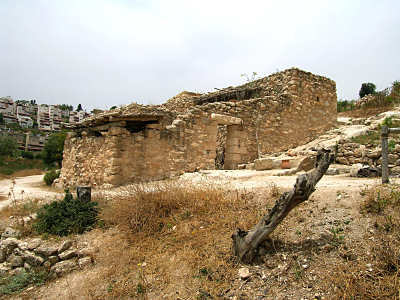
Click picture
for higher-resolution version.
|
|
By the end of visiting dozens of archaeological sites around
Israel, my students can be quite frustrated with the "piles of rocks" that
start to look all the same. At Nazareth Village, though, they have "put the roof
on," so one can better visualize what ancient houses were really like.
Archaeologists were part of the construction process, so the buildings are
as authentic as present knowledge allows. In addition to the
houses, a 1st century synagogue was also reconstructed. |
|
The Meal |
|
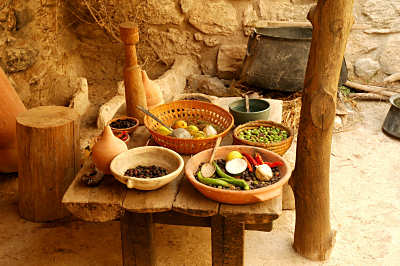
Click picture for
higher-resolution version.
|
|
Crops harvested on site are prepared for the table.
Common foods of the time included bread, olives, figs, and vegetable stew. |
|
The Carpenter's Workshop |
|

Click picture for
higher-resolution version.
|
|
According to most English translations of the Bible, Joseph was a
"carpenter." This reflects the European notion that a builder
primarily works with wood. But the word in Greek to describe Joseph
and his son is literally "builder," which can indicate woodworking, or more
likely in ancient Galilee, stone. Like today, stone was more readily
available than wood and was the primary building material. |
|
The Weaver's Loom |
|
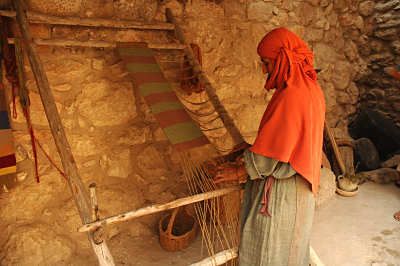
Click picture for
higher-resolution version.
|
|
Typically women did the spinning and weaving at home.
First the wool was spun into thread using a large stick (distaff).
The spindle is held in the hand and rotates as the thread is wound around
it. The thread is then woven on a loom into various types of
textiles. |
|
The Olive Press |
|

Click picture for
higher-resolution version.
|
|
Olives are harvested in the fall and brought to the press
where a large millstone crushed the fruit to produce virgin oil.
Then a beam-press was operated to extract the second-grade oil from the
pulp. Olive oil was used for food, lighting, cosmetics, and
anointing. |
|
Conversation |
|
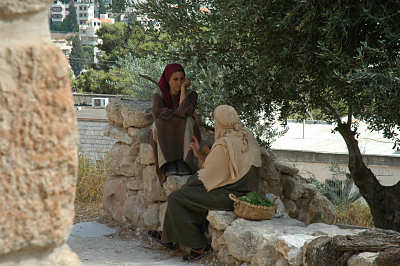
Click picture for
higher-resolution version.
|
|
Work was punctuated with breaks for rest and
conversation. These women sit in the shade of an olive tree. The idyllic scene in biblical language is of each man
sitting "under his own vine and fig tree" (Zech 3:10). |
|
|
FORWARD THIS NEWSLETTER
Please pass this newsletter link on to others.
They can subscribe to this newsletter
here. It is cost-free and spam-free. Email addresses will never be used for any purpose
other than this newsletter. If you have questions about the
subscription process, see
this page.
To subscribe or unsubscribe to this newsletter,
click here.
All contents (c) 2006 Todd Bolen. Text and
photographs may be used for personal and educational use.
Commercial use requires written permission.
|
|

